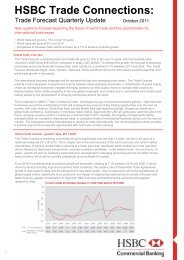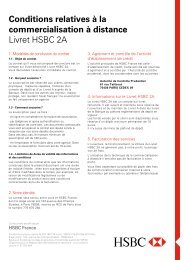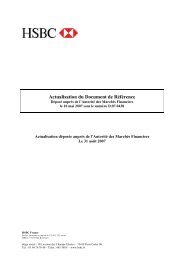The World in 2050-Quantifying the shift in the global economy - HSBC
The World in 2050-Quantifying the shift in the global economy - HSBC
The World in 2050-Quantifying the shift in the global economy - HSBC
- No tags were found...
Create successful ePaper yourself
Turn your PDF publications into a flip-book with our unique Google optimized e-Paper software.
EconomicsGlobal4 January 2011abc This may have implications for <strong>the</strong> ability of <strong>the</strong>se economies to <strong>in</strong>fluence <strong>the</strong> <strong>global</strong> policy agenda.Already Europe has been forced to concede two seats on <strong>the</strong> IMF’s executive board <strong>in</strong> order to makeway for some emerg<strong>in</strong>g economies. This adds a whole new dimension to <strong>the</strong> current Eurozone crisis,and provides a significant <strong>in</strong>centive to euro-area countries to work through <strong>the</strong>ir current difficultiesand rema<strong>in</strong> a union. Demographic change is even more dramatic outside of Europe. <strong>The</strong> work<strong>in</strong>g population will rise by73% <strong>in</strong> Saudi Arabia and fall by 37% <strong>in</strong> Japan. That is reflected <strong>in</strong> <strong>the</strong>se countries' differ<strong>in</strong>g fortunes<strong>in</strong> our top 30 table (Chart 4). By <strong>2050</strong>, <strong>the</strong> seismic <strong>shift</strong> <strong>in</strong> <strong>the</strong> <strong>global</strong> <strong>economy</strong> will have only just begun. Despite a seven-fold<strong>in</strong>crease (Chart 5), <strong>in</strong>come per capita <strong>in</strong> Ch<strong>in</strong>a will still be only 32% of that <strong>in</strong> <strong>the</strong> US and scope forfur<strong>the</strong>r growth will be substantial. This ‘base effect’ must be considered when compar<strong>in</strong>g currentgrowth <strong>in</strong> <strong>the</strong> emerg<strong>in</strong>g world with that of <strong>the</strong> developed world. Energy availability need not h<strong>in</strong>der this path of <strong>global</strong> development so long as <strong>the</strong>re is major<strong>in</strong>vestment <strong>in</strong> efficiency and low-carbon alternatives. Meet<strong>in</strong>g food demand may prove more of achallenge, but improvements <strong>in</strong> yield and diet could fill <strong>the</strong> gap. In <strong>the</strong> f<strong>in</strong>al section, we discuss ourprelim<strong>in</strong>ary thoughts on this topic.1. Growth <strong>in</strong> <strong>the</strong> emerg<strong>in</strong>g markets will boost <strong>global</strong> growth% Contributions to <strong>global</strong> growth%4.04.03.03.02.02.01.01.00.00.0Source: <strong>HSBC</strong> Calculations1970s 1980s 1990s 2000s 2010s 2020s 2030s 2040sDev eloped Markets Emerg<strong>in</strong>g markets Global2
















